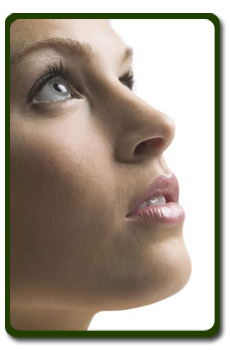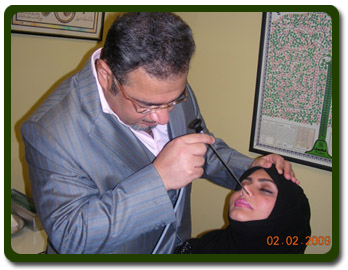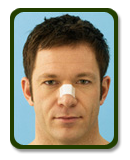|
Nasal Surgery (Rhinoplasty)
Surgery of the nose
 Rhinoplasty, or surgery to reshape the nose, is one of the most common of all
plastic surgery procedures. Rhinoplasty can enhance your appearance and your self-confidence.
It can reduce or increase the size of your nose, change the shape of the tip or the bridge,
narrow the span of the nostrils, or change the angle between your nose and your upper lip.
It may correct a birth defects or injury, or help relieve some breathing problems. Nothing has
a greater impact on how a person looks than the size and shape of the nose. As the nose is
the most defining characteristic of the face, a slight alteration can greatly improve one's
appearance.
Rhinoplasty, or surgery to reshape the nose, is one of the most common of all
plastic surgery procedures. Rhinoplasty can enhance your appearance and your self-confidence.
It can reduce or increase the size of your nose, change the shape of the tip or the bridge,
narrow the span of the nostrils, or change the angle between your nose and your upper lip.
It may correct a birth defects or injury, or help relieve some breathing problems. Nothing has
a greater impact on how a person looks than the size and shape of the nose. As the nose is
the most defining characteristic of the face, a slight alteration can greatly improve one's
appearance.
If considering rhinoplasty then, this website will give you some understanding of the
procedure. It can not answer all of your questions, since a lot depends on the individual
patients and the surgeon. Successful plastic surgery is a result of a good rapport
between patient and the surgeon.
Is Rhinoplasty for you?
The best candidates for rhinoplasty are people who are looking for improvement,
not perfection, in the way they look. If you are physically healthy, psychologically
stable and realistic in your expectations then you may be a good candidate. Rhinoplasty
can be performed to meet aesthetic goals or for reconstructive purposes to correct
birth defects or breathing problems.
Skin type, ethnic background and age are important factors to be considered in
discussions with your surgeon prior to surgery. Many surgeons prefer not to operate
on teenagers until after they have completed their growth spurt around 14 or 15 for girls,
a bit later for boys. Exceptions are cases which breathing is severely impaired.
Before deciding on rhinoplasty ask your surgeon if any additional surgery might
be recommended to enhance the appearance of your face. Some patients have chin
augmentation in conjunction with rhinoplasty to create a better balance of features.
|
Making a decision for rhinoplasty
 Selecting a qualified facial plastic surgeon is of paramount importance to your experience.
Many facial plastic surgeons are trained in both ear, nose, throat and facial cosmetic
surgery which provides the patient with the highest level of training and expertise.
Selecting a qualified facial plastic surgeon is of paramount importance to your experience.
Many facial plastic surgeons are trained in both ear, nose, throat and facial cosmetic
surgery which provides the patient with the highest level of training and expertise.
Good communication between you and your surgeon is essential. In your initial consultation,
the surgeon will take photos of you, ask you what you would like your nose to look like,
evaluate the structure of your nose and face and discuss the possibilities with you.
The surgeon will also explain the factors that can influence the procedure and the results.
Those factors include the structure of your nasal bones and cartilage, the shape of your face,
the thickness of your skin, your age and your expectations.
Your surgeon will also explain the techniques and anesthesia that will be used in the
procedure, the type of facility where the surgery will be performed, the risks and costs
involved and any options you may have.
It is important to tell your surgeon if you have had any previous nose surgery or any
injury to your nose, even if it was many years ago. You should also inform your surgeon
if you have any allergies or breathing difficulties, if you are taking any medications,
vitamins or if you smoke.
Do not hesitate to ask your doctor any questions you may have, especially those
regarding your expectations and concerns about the results.
|
Understanding the surgery
Rhinoplasty can be performed under local or general anesthesia, depending on the
extent of the procedure and on what you and your surgeon prefer.
It usually takes an hour or two though complicated procedures may take longer.
During surgery incisions are made and the skin of the nose is separated from its supporting framework of bone and cartilage. The majority of incisions are made inside the nose, where they are invisible. Certain amounts of the underlying bone and cartilage are removed or rearranged to provide a newly shaped structure. Finally, the skin is redraped over the new framework and the incisions are closed. A splint is applied to the outside of the nose to help retain the new shape while the nose heals. Nasal packs or soft plastic splints also may be places in your nostrils to stabilize the septum, the dividing wall between the air passages. Risk factors in rhinoplasty are generally minor and your surgeon will discuss these prior to surgery.
|
What to expect after the surgery?
 After the surgery,
particularly during the first twenty-four hours your face will feel puffy, your nose may ache and you may have a dull headache.
You can control any discomfort with the pain medication prescribed by your surgeon. A little bleeding is common
during the first few days following surgery and you may feel stuffiness for several weeks. Your surgeon will probably ask you not to blow your nose for a week or so, until the tissues heal. You will notice that the swelling and bruising around your eyes will increase at first, reaching
a peak after two or three days. Applying cold compress will reduce this swelling. Most of the swelling and bruising should disappear within two weeks.
After the surgery,
particularly during the first twenty-four hours your face will feel puffy, your nose may ache and you may have a dull headache.
You can control any discomfort with the pain medication prescribed by your surgeon. A little bleeding is common
during the first few days following surgery and you may feel stuffiness for several weeks. Your surgeon will probably ask you not to blow your nose for a week or so, until the tissues heal. You will notice that the swelling and bruising around your eyes will increase at first, reaching
a peak after two or three days. Applying cold compress will reduce this swelling. Most of the swelling and bruising should disappear within two weeks.
If packing is placed inside the nose during surgery, it is removed the morning following surgery. Absorbable sutures are usually used that do not have to be removed. Nasal dressing and splints are usually removed six to seven days after surgery. It is crucial that you follow your surgeons directions, especially instructions to keep your head elevated for a certain time after surgery. Most rhinoplasty patients are up and about within two days and are able to return to sedentary work a week or so following surgery. It will be several weeks, however, before you are entirely up to speed.
Your surgeon will give you specific guidelines for gradually resuming your normal activities. You will be told to avoid strenuous activity, avoid hitting or rubbing your nose and getting it sunburned in the weeks after the procedure. Be gentle when washing your face and hair using cosmetics. If you wear glasses, once the splint is off, they'll have to be taped to your forehead or propped on your checks to avoid them resting on the bridge of the nose.
Follow-up care is vital for this procedure. Your surgeon will schedule frequent follow-up visits in the months after surgery, to check on the progress of your healing. If you have any unusual symptoms between visits, or any questions about what you can and you can't do, don't hesitate to call your director. Healing is a slow and gradual process. Some subtle swelling may be present for months, especially in the tip. The final results of rhinoplasty may not be apparent for a year or more.
Now you can book your Rhinoplasty Surgery in Dubai with Dr. Bashar Bizrah.
|
|







